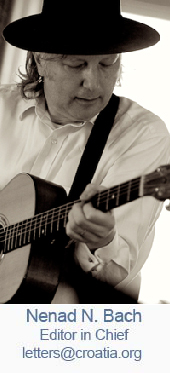
Sponsored Ads
|
| Croatian Easter Eggs |
| By Nenad N. Bach and Darko Žubrinić |
Published
04/2/2010
|
Culture And Arts
|
Unrated
|
|
|
|
Happy Easter - Sretan Uskrs
Croatia has a long and rich tradition of beutifully painted Easter eggs prepared within families during Lenten time. On the left are a few such eggs from a large ethnographic collection exhibited in the famous Franciscan convent of Kraljeva Sutjeska in Bosnia and Herzegovina. Below you can also see an Easter egg that was exhibited in Međugorje. We take the opportunity to wish all the readers of the CROWN and their families a happy and blessed Easter.
| Easter eggs from Bosnia and Herzegovina, on the right above from Ukraine

The above photo by Maria Vasilj Easter egg from the heart to Medjugorje
date: 22.03.2010.
The largest Croatian Easter egg, Easter egg from the heart, 2.05 m tall, 1.5 m wide, with a stand that is 120 kg heavy, gift of Koprivnica - Krizevci County, was officially exposed in front of the church of St. James in Medjugorje. This event was even more beautiful thanks to singing of Children Choir "Doves of Peace” and its leader Sr. Slavica Kozul from Medjugorje and Cultural Club from Koprinica. At the beginning of event Ivo Jerkic, Mayor of Citluk, gave a talk to everybody present. He said how he hopes that this “Easter egg from the heart" will be sign of friendship, that through Medjugorje it will send message of peace. Head of Koprivnica - Krizevci County, Darko Koren, said that project “Easter egg from the heart” was started in 2007, with desire that large Easter egg, symbol of friendship, love and joy of Easter is taken all over Croatia and rest of the world.
These large Easter eggs were painted by naďve expression artists Djuro Jakovic, Drago Zufika, Josip Tot and Drago Kovacic. All together they gave life to these Easter eggs, as well as recognizable note of everyday life and tradition of Podravina region. Fr. Petar Vlasic, as Medjugorje parish priest and host, greeted everybody present and said: "This celebration and public exhibition of large Easter egg happens exactly at the time when Bjelovar and Krizevci, two Croatian towns, become even more related with foundation of new Bjelovar - Krizevci Diocese. This large Easter egg witnesses richness of Croatian expression, since Croatian people for many centuries grew into reality of our faith, into Jesus Christ, Crucified and Risen."
Some of the most famous naďve expression artists were born in the region of Koprivnica - Krizevci County. On Wednesday, March 17th 2010, Easter egg was also given as a gift to Holy Father, Benedict XVI. This Easter egg will remain in Medjugorje, in front of the church of St. James until Easter. Medjugorje Official
Source ingodscompany2.blogspot.com
|   Zdenka Sertić 1899-1986: Uskrs u Šestinama - Easter in ŠestineMany thanks to Dr. Mladen Ibler, Denmark, for sending me this beautiful photo. Šestine is a small village, now a part of Croatia's capital Zagreb. 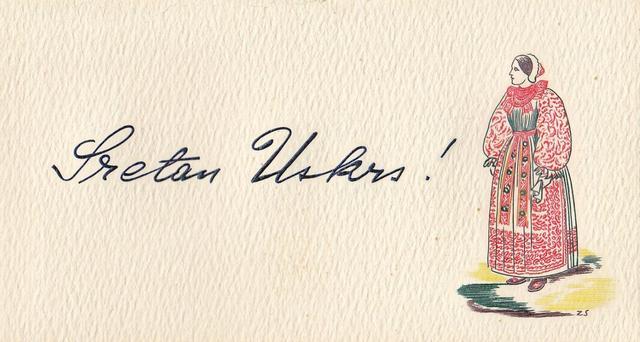
"Klepetaljke" and "Cegrtaljke"
One of the oldest traditions is making "klepetaljke" and "cegrtaljke" (very similar to rattles and clappers), particularly popular in central Dalmatia and the Konavle region. They vary from region to region, while those on the island of Krk are especially interesting: metal plates that hang at the end of a 30 cm board that has the width of a bookshelf produce strong sounds when the device is shaken. In other regions, "klepetaljke" were made differently: small wheels were attached to wooden boards and connected to metal sprockets; the whole device made a rattling noise when pulled.
Drinking of Wine
This custom originated in ancient times, nevertheless it is still followed nowadays. Since people used to believe that wine transformed into blood in the body and made people stronger and healthier, it was recommendable to drink it as much as possible for Easter. There was plenty of wine served on Easter and people used to drink it without water. Documents from the island of Brac show that housewives used to prepare, among other dishes, cod and cabbage, food that makes people thirsty so that they could drink as much as possible. It has been documented that a certain inhabitant of the island of Brac drank 10 l of pure wine on Easter!
Weaving of Branches
Since palms can rarely be found on the Adriatic, people mostly use olive or rosemary branches and flowers. Nevertheless, chronicles from the city of Split show that people used to gather on Easter at the only palm tree in the city, located in the garden of a certain inhabitant, in order to collect palm branches. The inhabitants of Brac used to manage in a different way: they used to ship palm branches from the island of Vis, where palm trees can be found in abundance, and distribute them to the islanders. The branches were decorated with crosses or wreaths made of ribbons and flowers. This skill was so respected that one decorated branch could be exchanged for Easter bread and 20 colorfully decorated eggs. On the island of Korcula and in the surroundings of Sibenik, olive branches were woven into plaits, while branches were woven into wreaths with crosses in Istria.
Coloring of Eggs
There are several ways of decorating Easter eggs. The best known method is to use hot liquid wax with the help of pencil-like instruments. After coloring, the wax is removed, revealing the splendid decorations. Before artificial coloring, eggs were colored by being boiled in water with onions, walnuts, roots and herbs. In order to get their shine, they were polished with oil before being placed in the basket. Another method of decorating, popular in continental Croatia, was to use a knife, as well as threads of silk and wool, while the third method was to use formic acid.
Eggs in the southern part of Croatia are traditionally colored in red and have white star or rosette shaped decorations, while decorations such as pine branches, flowers, circles and spirals are more common in other parts of the country. Finally, there is one more custom related to Easter eggs - the so-called "tuca" (egg fight). Everyone would choose an egg from the basket and would hit it against their adversary's egg. The winner would be the person whose egg remained intact throughout the "fight".
   
 Source www.adriatica.net/croatia
| 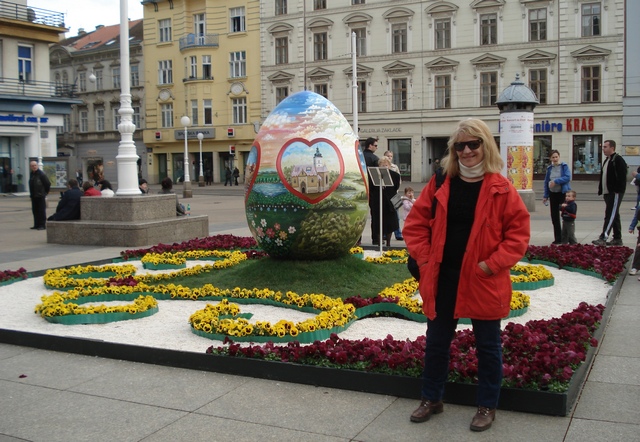 Carmen Verlichak, Argentinean writer of Croatian descent, at the Jalačić Square in Croatia's capital Zagreb. Her recent book Croacia - quadernos de un pais (Croatia - Note-book of a Country) has been promoted in Croatia. 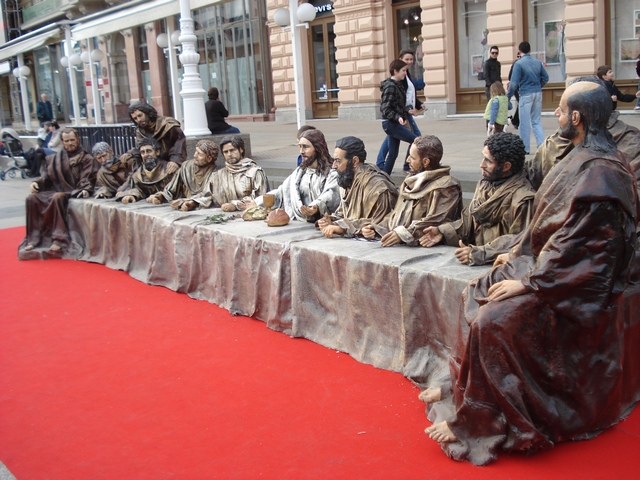 Zvonimir Mihanović Zvonimir Mihanović: Posljednja večera - The Last Supperexhibited at the Jelačić Square in Zagreb 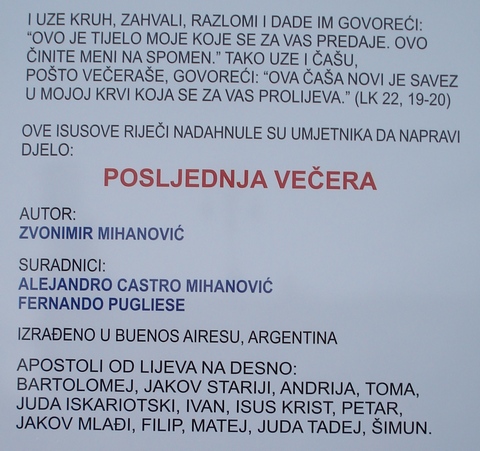 The Last Supper The Last Supper has been created in Buenos Aires, Argentina The Zagreb Bus Station
Jelačić Square in Croatia's capital Zagreb, photos by Snježana Božić
Formated for CROWN by prof.dr. Darko Žubrinić
Distributed by www.Croatia.org . This message is intended for Croatian Associations/Institutions and their Friends in Croatia and in the World. The opinions/articles expressed on this list do not reflect personal opinions of the moderator. If the reader of this message is not the intended recipient, please delete or destroy all copies of this communication and please, let us know! |
Related Articles
Related Links
Comments
-
Comment #1
(Posted by Mirjam....)
The photo's are very beautiful......
-
Comment #2
(Posted by Iva)
Izvrsno! Veoma mi je drago da imamo ovako lijepih stvari, osebujne su i naše.
Puno srdačnih pozdrava uz želje za SRETAN I VESEO USKRS !!!
Submit Comment
|
|